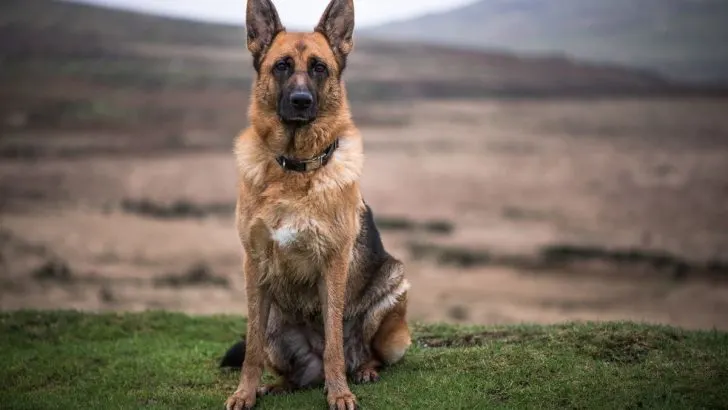I am a person whose life is being made miserable via a new German Shepherd puppy, and just months ago, I was considering all the possible German Shepherd colors my new working line puppy might be.
Let me tell you, during this article, you are going to see all the different types of German shepherd colors, and you will fall in love with the variety of colors this breed offers.
Most people are only familiar with the short-haired saddle pattern type of these marvelous dogs, but that is not even the best color the coats of a German shepherd can come up with!
If we look at the German Shepherd Dog Club of America, they state the coat color of a German Shepherd may vary, although strong, rich colors are preferred.
Faint and washed-out off-colors and even blues or livers are extreme faults. However, an entirely white dog must be disqualified.
Color Variations In The German Shepherd Dog
German Shepherd dogs are known to have a double coat. This is made up of a topcoat and a thick undercoat. Two types of the coat are the standard coat and the long coat.
The standard coat is also called a stock coat. At the same time, the long coat is called a long stock coat. The longer coat still maintains an undercoat while the topcoat grows in length.
We have about 15 different GSD colors that might be similar in some details, although each has at least one thing that separates them from the others.
There are ten standard colors (some will be considered unusual depending on your area) and five truly unique hues that can rarely be seen in any part of the U.S.
1. The Black German Shepherd
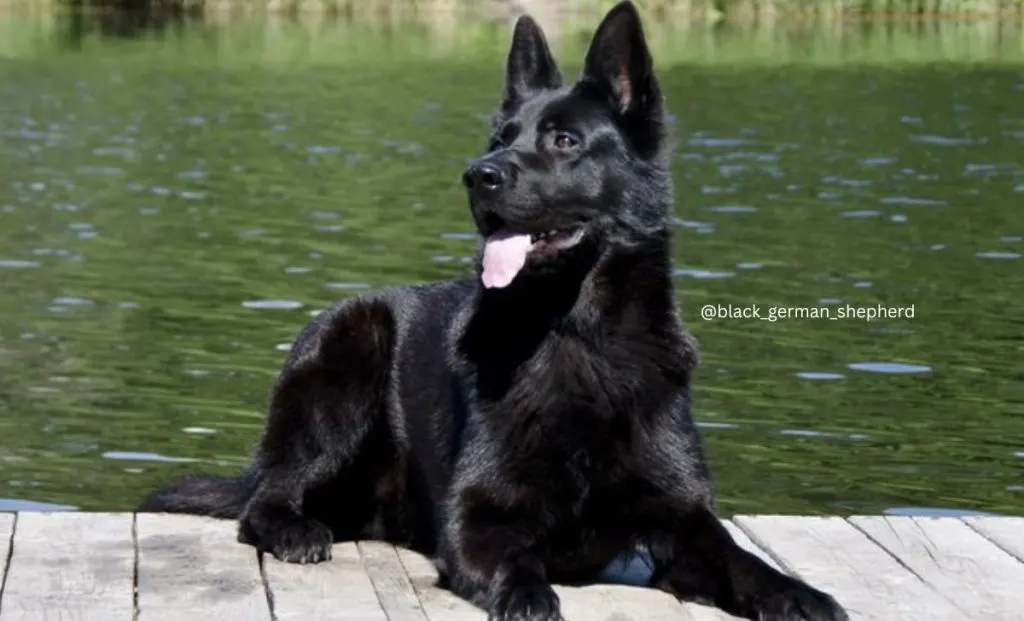
The dark coat, fully black German Shepherds are not an everyday sight. Black GSDs are among the rarest German Shepherd colors, if not the rarest.
A German Shepherd in the color black is just as it sounds – a solid black dog. In a traditional German Shepherd genetic table – black is a recessive gene. Both parents must carry the black gene to produce a solid black pup.
Solid Black pups are born black and have no tan accents anywhere. Tiny patches of white might be present at birth (on the dog’s chest or the paws), but they should disappear as the pup ages.
Black German Shepherds are usually from working lines. Since my female Shepherd puppy is solid black, I can tell you from experience, everybody thinks she is a Malinois. The two breeds have many distinctions, including size and color as the most obvious ones. You can check out the Belgian Malinois colors here.
2. The Gray German Shepherd

The gray German Shepherd color differs from the silver or blue GSD and should not be confused with them.
Most people would agree that this type of Shepherd resembles a wolf more than a dog because the coat is covered with shades of gray. Many controversies about this color have existed for a long time within breed lovers.
There have been claims that gray German Shepherds are the same as the sable or the agouti color pattern. However, according to the breed standard, the American Kennel Club (AKC) has officially acknowledged the gray shade as an acceptable solid color of the GSD.
Most gray GSDs don’t have any black pigment, unlike the light sable and dark sable ones that commonly have at least black hair ends on their coat.
The gray color is also fascinating because it is not a recessive gene, but a dominant one. That is why gray German Shepherds are undemanding to breed.
It only takes one parent in the breeding with a gray gene to create a gray GSD! However, there’s a way for the pups to exhibit a recessive gene, but only if both parents carry it.
Panda and Isabella are rarer colors than gray, but this color isn’t as common as the black and tan combination.
3. The Silver German Shepherd

Interestingly, silver is recognized as a different color from gray, even though they both derive from the same type of genes.
The silver color is more uncommon among this breed, but it is easier to find a reputable breeder of silver-colored German Shepherds than it is to find a breeder of gray GSDs.
Unlike the gray color, silver is made by a recessive gene that includes the black pigment. A silver sable GSD also exists, but it’s not recognized as an official color within the breed because the shade seems more sable than silver.
The silver-colored GSDs are more common in the police and the military as working dogs than in dog shows because dog shows require vibrant shades rather than dark colors.
4. The White German Shepherd

If you ever saw a white German Shepherd, you might have even though it was a white Golden Retriever with upright ears.
There’s also a remarkable resemblance between the white German Shepherd and the Berger Blanc Suisse, a dog breed from Switzerland, also known as the White Swiss Shepherd.
The U.K. (K.C.) and the American Kennel Club (AKC) do not always agree on breed standards and policies. Still, both of them find the white color unacceptable, especially in dog shows and competitions.
The K.C. might be more flexible by admitting light shades on the chest or legs of the dog, even though these spots and marks aren’t desirable.
However, the United Kennel Club (UKC) accepted the white coat color of this breed, and they added it to the list of the official colors of the GSD.
5. The Bicolor German Shepherd

The bicolor is a classic pattern in this breed where the saddle pattern covers most of the body, leaving markings on the feet and, in some rare cases, on the face.
Bicolor and black and tan colorings are similar, so some people might get confused trying to identify them. But if you know what to look for, it is relatively easy to notice the difference.
The bicolor GSD has more black on the coat than the black and tan type. The head, tail, legs (and heels), and the back of the dog should be covered in solid black.
According to the American Kennel Club, this color is recognized as a shade from a recessive gene.
If you plan to get a GSD of this color to take them to conformation events organized by the American Kennel Club, you should know that they’re pretty rare and hard to come by as they’re typically used as working dogs.
6. The Black And Silver German Shepherd

Here’s another exhilarating mix of colors that makes the gorgeous coat of the German Shepherd even more extraordinary.
This color’s gene is also recessive, and the silver parts are commonly positioned on the back but might also appear elsewhere.
This type (better to say, color) of dog isn’t favored at dog competitions, but it’s a well-familiar face in the working lines.
7. The Black And Tan German Shepherd

Many people who aren’t quite knowledgeable about the German Shepherd dog type and color deviations think there’s only a black and tan mix of colors.
The face and back of the GSD in black are already characters of black and tan coloring, along with the tan markings over the dog’s body (usually found on the chest, muzzle, paws, etc.).
It would be an understatement to say that this color appears due to a recessive or dominant gene, mainly because it dominates the black-colored canines, even though it remains recessive to most stronger sable genes.
Interestingly, the black and tan German Shepherd pups are much darker than the same-colored adult versions. This happens because the coat becomes lighter as they grow older.
The tanned part might become a gray line over the years, but this usually happens in the female canines of the breed.
8. The Black And Cream German Shepherd
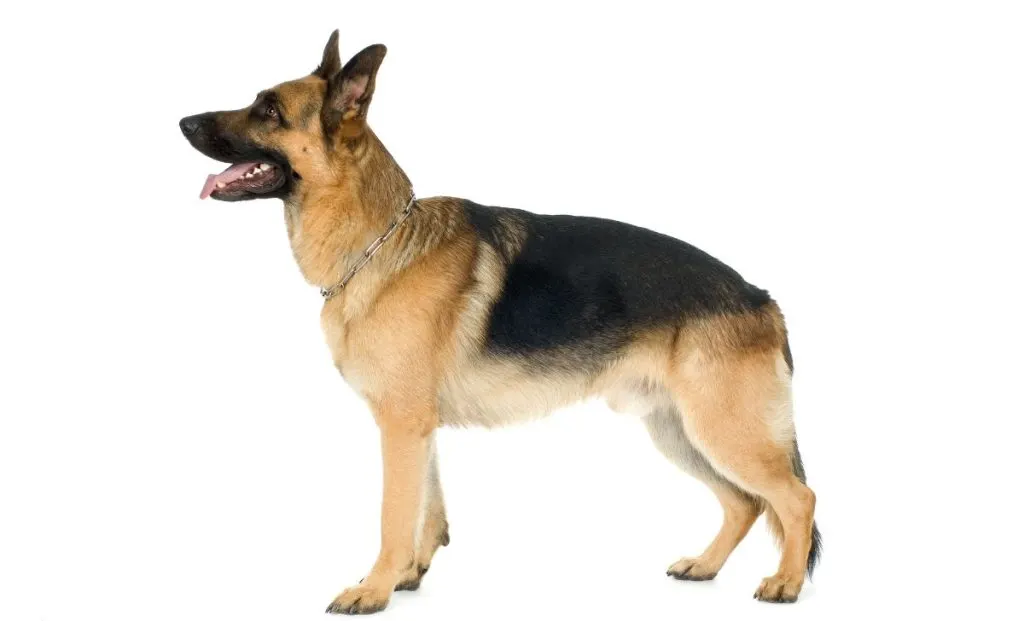
The officially accepted color in the breed standard, the black and cream GSD, deserves a mention in this list.
As we said before, a black and tan GSD coat becomes lighter as it ages, so some might mistake it for the black and cream combination.
However, most reputable breeders acknowledged by the AKC don’t like having a black and cream GSD in show rings. They want to breed a dog with as little cream color as possible.
The color might be necessary for dog shows, but it doesn’t impact the dog’s personality or temperament, and the black and cream GSD is the perfect example of this.
Like its differently-colored relatives, this dog is loyal, hard-working, and agile.
9. The Black And Red
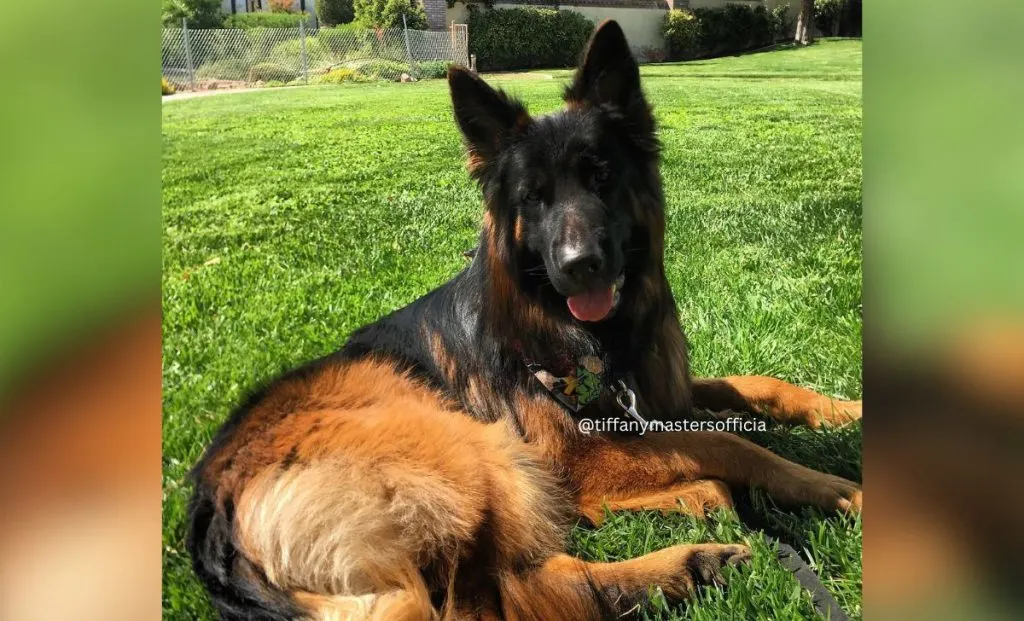
If you’re a fan of red color, I’m sure you will love a black and red GSD, one of the most recognized colors in this breed, that’s physically very close to its black and tan cousin.
The red pigment replaces every tanned part, while everything else remains the same color.
This kind of German Shepherd retains the black saddle and matching color patterns, which explains why it’s one of the most bred color combinations among GSD breeders.
Both of these hues are results of the dominant gene, which makes them more
common. Plenty of breeders are concentrated on breeding red-colored German Shepherds only.
10. The Sable

This is a standard color among GSDs, and it comes in a few shades with black tips on the hair.
The sable-colored GSDs can consist of these hues:
- Black
- Red
- Silver
- Tan
- Gray
The sable color in this breed is also called “agouti,” and it represents a wolf-like coat shade.
This color was considered the only officially acknowledged GSD color for quite a long time. The coloring isn’t visible right after the pup is born.
Most of the young dogs in this breed remain black or black and brown for the first few years of their life (some puppies might show the difference after several months, but some might take up to three years to show).
Sable-colored GSDs are very easy to breed because they carry the dominant gene. This means the puppies will almost always come out sable no matter the color they are mixed with.
It might be essential to mention that even though black and tan dogs are widespread, the sable GSD was the original German Shepherd of the working line.
Unique German Shepherd Colors
Most unique German Shepherd colors are hard to find because they are non-standard colors considered a fault.
Because of this, most GSD breeders try to minimize the number of such dogs and produce only AKC or KC acknowledged colorings.
Yet, just because a color is regarded as non-standard according to specific organizations and kennel clubs doesn’t mean the canine isn’t a purebred dog.
Each color type mentioned below is a purebred German Shepherd, but they’re marked with a unique shade that makes them stand out.
11. The Blue German Shepherd

This color is unique. There’s a significant demand for blue German Shepherds, but on the other hand, there’s just as much controversy and problems surrounding the whole color thing.
The dilution gene is often related to genetic health conditions, so blue or white dogs are undesirable.
12. The Liver German Shepherd

A liver German Shepherd might sport a completely different color, but it’s the same dog in character and nature.
This shade looks more like a washed-out red color that turns amber and brown in certain places. This color appears in body parts, usually black (the back, the legs of the dog, etc.).
Therefore, instead of the black mask, the liver GSD must have a red mask that turns brown around the nose of the dog, the paws, the muzzle, etc.
The American Kennel Club doesn’t accept this color as an official Shepherd coloring unless it’s an intense liver shade (almost the same as red).
As it is known, most of the big kennel clubs and canine organizations prefer rich coat colors over faded shades, which is considered a significant fault. All these rules and regulations might sound confusing, but there is a good logic behind them.
The American Kennel Club also does not recognize any liver combination colors, which means that the liver and black combo, or the liver and tan color, are out of every AKC dog show or contest.
The Liver GSD bloodline is not easy to find, but if you invest enough money, time, and effort, you’ll have this rare canine in your home in no time.
13. The Panda German Shepherd
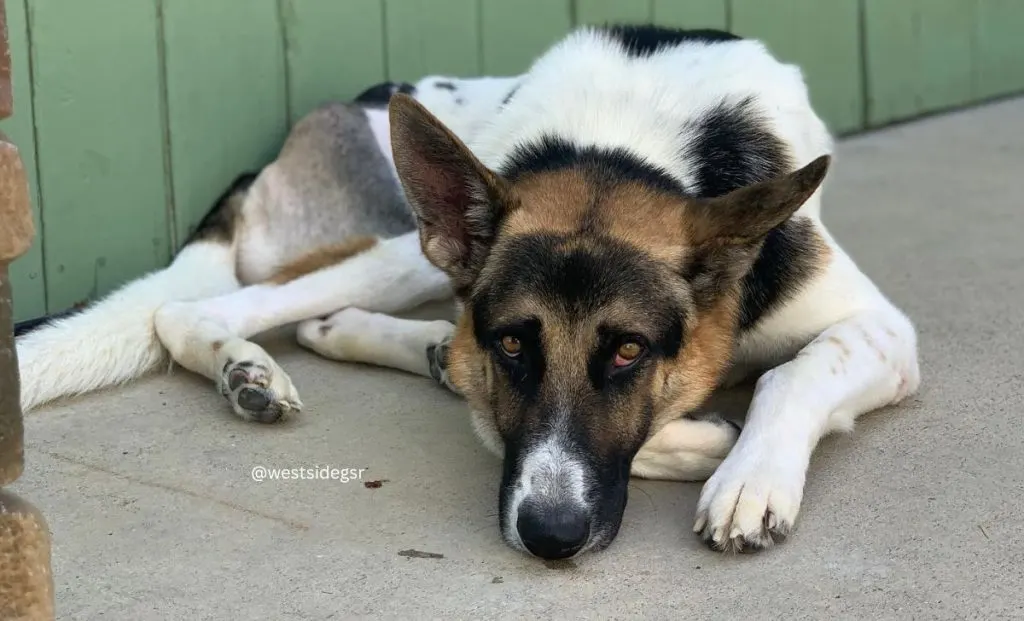
Before, panda GSDs were thought to be a mixed breed until DNA testing showed and proved that this type of GSD is also a purebred, just like the other color variations.
This shade is deemed a genetic mutation rather than an official shade, so most organizations and breeders do not want to accept it.
Like most kennel organizations, the AKC does not acknowledge the panda GSD, which does not make them any less popular!
The price of these dogs also grows with their popularity, so it’s no surprise that these pups are more expensive now than in the past. Puppy mills use the situation to mass produce this color without concern for the dog’s health.
That’s precisely why every potential dog owner needs to be very careful and only choose trustworthy breeders.
14. The Albino German Shepherd
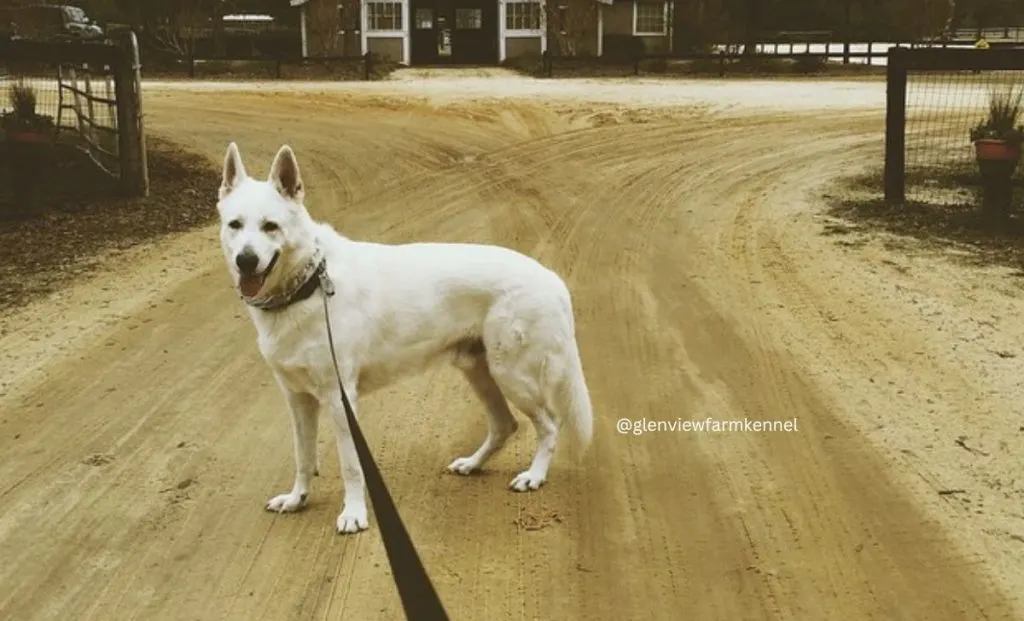
Albinos are an extraordinary sight not only among German Shepherds but also in other dog breeds and species.
Depigmented eyes, hair, or the whole body (skin) are all signs of albinism. However, not all white canines are albinos; most albino German Shepherds are white German Shepherds.
The best route to bypass such confusion is to inspect the eyes of the dog. If the eyes and nose are pink or red, the dog is most likely an albino type.
This type of dog is sensitive and requires more attention than a regular pet.
One of the most common conditions affecting most albino Shepherds is photosensitivity. They must be protected from sunlight and UV rays to avoid side effects such as exhaustion, skin rashes, high fever, etc.
All dog breeds have albino types. The American Kennel Club has an excellent article about albinism in dogs.
Albino GSDs are incredible pets, just like any other German Shepherd type. If you’re looking for an unusual yet obedient and friendly family pet, an albino German Shepherd will surely fit your needs.
15. The Isabella German Shepherd

This color is an unusual sight, but the explanation of the origin might be more straightforward than you’d think.
This shade results from breeding one liver and one blue German Shepherd.
The fact that AKC and other reputable canine organizations do not recognize Isabella as an official color of the German Shepherd breed but rather as a severe fault.

Meet Iram, a devoted veterinarian, passionate dog lover, and current Ph.D. candidate at Utrecht University in the Netherlands. Seamlessly blending her roles as a vet and content writer, Iram channels her love for dogs into heartfelt narratives.
Since childhood, Iram nurtured a dream of becoming a vet, a passion that runs deep in her family. Having now fulfilled that dream, she’s eager to share her acquired knowledge. In her writing, Iram not only explores the emotional bond between humans and their canine friends but also integrates her veterinary expertise, offering readers a holistic understanding of their beloved pets.
